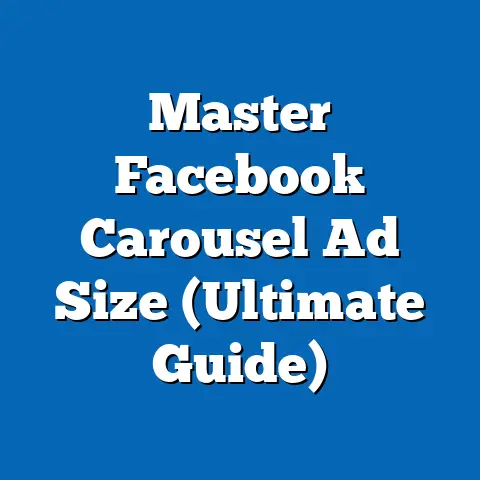Boost Chiropractor Results with Facebook Ads (Proven Strategies)
The chiropractic industry is booming, but with growth comes increased competition. It’s no longer enough to simply open your doors and expect patients to walk in. In today’s digital age, you need a strategic marketing plan, and Facebook Ads can be a game-changer. However, a one-size-fits-all approach won’t cut it. As a digital marketing specialist with years of experience helping healthcare professionals, I’ve learned that understanding and catering to regional needs is paramount for success.
Think about it: a chiropractor in sunny Southern California will likely have different patient demographics and needs than one in the snowy mountains of Colorado. Understanding these regional nuances is crucial for crafting effective Facebook Ad campaigns that resonate with potential patients and drive them through your door.
Section 1: Understanding Regional Needs
Before you even think about creating an ad, you need to understand who you’re trying to reach. This means diving deep into the specific characteristics of your region. Remember, what works in New York City might completely bomb in rural Montana. Let’s break down the key areas you need to analyze.
Subsection 1.1: Demographic Insights
Demographics are the foundation of any successful marketing strategy. Understanding the age, income, education level, and health awareness of your target audience in your region is critical. Fortunately, Facebook provides powerful tools to help you gather this information.
Age: Are you in a region with a large senior population? Or are you surrounded by young families? This will significantly impact the type of services you promote. For example, a chiropractor in a retirement community might focus on ads targeting seniors with age-related issues like arthritis and back pain. On the other hand, a chiropractor near a college town might focus on sports injuries and preventative care for young adults.
Income: Income levels can influence the affordability of your services. If you’re in a high-income area, you might consider promoting premium services like massage therapy or specialized treatments. In a lower-income area, you might focus on affordable packages and payment plans.
Health Awareness: How health-conscious is your community? Are people actively seeking out preventative care? Or are they more likely to wait until they’re in pain before seeking treatment? If your region has a high level of health awareness, you can focus on ads that promote wellness and preventative care. If not, you might need to focus on ads that address specific pain points and offer immediate relief.
How to Gather Demographic Data:
- Facebook Audience Insights: This tool provides valuable insights into the demographics, interests, and behaviors of people on Facebook. You can use it to analyze the characteristics of people who like your page or who are interested in chiropractic services in your region.
- U.S. Census Bureau: The Census Bureau provides detailed demographic data for every region in the United States. You can use this data to get a comprehensive understanding of the population in your area.
- Local Market Research: Conduct your own research by surveying your existing patients and asking them about their demographics and health needs. You can also attend local community events to learn more about the people in your region.
Key Takeaway: Understanding the demographics of your region is the first step towards creating effective Facebook Ads. Use Facebook Audience Insights, the U.S. Census Bureau, and local market research to gather valuable data and tailor your ads accordingly.
Subsection 1.2: Local Health Trends
Beyond demographics, you need to be aware of the common health issues prevalent in your specific region. Are there certain industries that dominate the local economy, leading to specific types of injuries? Are there environmental factors that contribute to certain health problems?
Examples of Local Health Trends:
- Urban Areas: Sedentary lifestyles and long commutes in urban areas often lead to back pain, neck pain, and carpal tunnel syndrome.
- Rural Areas: Farming and other physically demanding jobs in rural areas can lead to musculoskeletal injuries and chronic pain.
- Coastal Areas: Surfing and other water sports in coastal areas can lead to shoulder injuries, back pain, and neck pain.
- Mountainous Areas: Skiing, snowboarding, and other winter sports in mountainous areas can lead to knee injuries, back pain, and head injuries.
How to Identify Local Health Trends:
- Talk to Your Patients: Ask your patients about the types of health issues they’re experiencing and what they think is contributing to those issues.
- Research Local News and Health Reports: Stay up-to-date on the latest health trends in your region by reading local news articles and health reports.
- Consult with Other Healthcare Professionals: Talk to other healthcare professionals in your area, such as doctors, physical therapists, and massage therapists, to get their insights on local health trends.
Tailoring Your Ads to Local Health Trends:
Once you’ve identified the common health issues in your region, you can tailor your Facebook Ads to address those specific pain points. For example, if you know that back pain is a common problem in your area, you can create ads that highlight your expertise in treating back pain and offer solutions for relieving back pain.
Key Takeaway: Identify the common health issues in your region and tailor your Facebook Ads to address those specific pain points. This will make your ads more relevant and engaging to potential patients.
Subsection 1.3: Community Engagement
Building trust and credibility within your community is essential for attracting new patients. People are more likely to choose a chiropractor who is actively involved in the local community and who is seen as a trusted resource.
Ways to Engage with Your Community:
- Sponsor Local Events: Sponsor local sports teams, charity events, or community festivals.
- Participate in Health Fairs: Set up a booth at local health fairs to provide information about chiropractic care and offer free screenings.
- Partner with Local Businesses: Partner with local gyms, yoga studios, and other health-related businesses to cross-promote your services.
- Offer Workshops and Seminars: Offer free workshops and seminars on topics related to health and wellness.
- Support Local Charities: Donate to local charities and participate in volunteer events.
Promoting Your Community Engagement on Facebook:
Make sure to promote your community engagement on your Facebook page. Share photos and videos of your participation in local events, and highlight your partnerships with local businesses. This will show potential patients that you’re invested in the community and that you care about their well-being.
Key Takeaway: Get involved in your local community and promote your engagement on Facebook. This will build trust and credibility, making you a more attractive choice for potential patients.
Section 2: Setting Up Effective Facebook Ads Campaigns
Now that you have a solid understanding of your regional needs, it’s time to start setting up your Facebook Ads campaigns. This involves defining your target audience, crafting compelling ad copy, and utilizing visuals and videos to capture attention.
Subsection 2.1: Creating Targeted Audiences
Targeting is the heart and soul of successful Facebook Advertising. You can have the most beautiful ad in the world, but if it’s not shown to the right people, it’s a waste of money. Fortunately, Facebook provides a wealth of targeting options to help you reach the specific demographics, interests, and behaviors of your ideal patients in your region.
Types of Targeting Options:
- Demographic Targeting: Target people based on their age, gender, education level, income, and other demographic factors.
- Interest Targeting: Target people based on their interests, such as health and wellness, sports, fitness, and nutrition.
- Behavioral Targeting: Target people based on their behaviors, such as their online activity, purchase history, and travel habits.
- Location Targeting: Target people who live in a specific city, state, or zip code.
- Custom Audiences: Target people who have previously interacted with your business, such as people who have visited your website, liked your Facebook page, or subscribed to your email list.
- Lookalike Audiences: Target people who are similar to your existing customers or website visitors.
Combining Targeting Options:
The real magic happens when you combine different targeting options to create highly specific audiences. For example, you could target women aged 35-55 who live in your city, are interested in health and wellness, and have visited your website in the past.
Key Takeaway: Use Facebook’s powerful targeting options to reach the specific demographics, interests, and behaviors of your ideal patients in your region. Combine different targeting options to create highly specific audiences and maximize the effectiveness of your ads.
Subsection 2.2: Crafting Compelling Ad Copy
Your ad copy is your chance to grab attention and persuade potential patients to learn more about your services. It needs to be clear, concise, and compelling.
Tips for Writing Effective Ad Copy:
- Focus on the Benefits: Don’t just talk about the features of your services; focus on the benefits that patients will receive. For example, instead of saying “We offer spinal adjustments,” say “Relieve your back pain and improve your posture with our gentle spinal adjustments.”
- Use Strong Headlines: Your headline is the first thing people will see, so make it count. Use strong, attention-grabbing headlines that highlight the benefits of your services.
- Use a Clear Call to Action: Tell people what you want them to do. Use a clear and concise call to action, such as “Schedule Your Appointment Today,” “Learn More,” or “Get a Free Consultation.”
- Use Numbers and Statistics: Numbers and statistics can add credibility to your ad copy. For example, you could say “80% of our patients experience significant pain relief after just one treatment.”
- Use Testimonials: Include testimonials from satisfied patients to build trust and credibility.
Examples of Effective Headlines:
- “Back Pain Relief in [Your City]”
- “Say Goodbye to Neck Pain with Chiropractic Care”
- “Improve Your Posture and Reduce Back Pain”
- “Get a Free Consultation with Our Experienced Chiropractor”
- “80% of Patients Experience Pain Relief After Just One Treatment”
Key Takeaway: Write clear, concise, and compelling ad copy that focuses on the benefits of your services and uses a strong call to action. Use numbers, statistics, and testimonials to add credibility.
Subsection 2.3: Utilizing Visuals and Videos
Visuals are incredibly important in Facebook Advertising. People are visual creatures, and they’re more likely to pay attention to ads that include eye-catching images and videos.
Tips for Using Visuals and Videos:
- Use High-Quality Images and Videos: Make sure your images and videos are high-quality and visually appealing.
- Showcase Your Services: Use visuals to showcase your services and the benefits they provide.
- Use Patient Testimonials: Use video testimonials to build trust and credibility.
- Use Before and After Photos: Use before and after photos to demonstrate the effectiveness of your treatments.
- Use Humor: Use humor to grab attention and make your ads more memorable.
Specific Visual Ideas:
- Images of your office: Show a clean, welcoming environment.
- Images of you with patients: Depict positive interactions and build trust.
- Short videos explaining common conditions: Educate your audience and position yourself as an expert.
- Animated graphics: Use simple animations to illustrate the benefits of chiropractic care.
Key Takeaway: Use high-quality images and videos to capture attention and showcase your services. Use patient testimonials, before and after photos, and humor to make your ads more engaging and memorable.
Section 3: Proven Strategies for Maximizing Facebook Ad Performance
Setting up your ads is just the beginning. To truly maximize your return on investment, you need to continuously monitor, test, and optimize your campaigns. This section will cover proven strategies for maximizing your Facebook Ad performance.
Subsection 3.1: A/B Testing for Optimization
A/B testing, also known as split testing, is a powerful technique for improving the performance of your Facebook Ads. It involves creating two or more versions of an ad and testing them against each other to see which one performs better.
Variables to Test:
- Headlines: Test different headlines to see which ones grab the most attention.
- Ad Copy: Test different ad copy to see which one is most persuasive.
- Images and Videos: Test different images and videos to see which ones are most engaging.
- Targeting Options: Test different targeting options to see which ones reach the most relevant audience.
- Call to Actions: Test different call to actions to see which ones generate the most conversions.
How to Set Up A/B Tests:
Facebook makes it easy to set up A/B tests. Simply create two or more versions of your ad and use Facebook’s A/B testing tool to split your budget between the different versions. Facebook will then track the performance of each version and show you which one is performing better.
Key Takeaway: Use A/B testing to continuously refine your ads and improve their performance. Test different headlines, ad copy, images, videos, targeting options, and call to actions to see what works best for your target audience.
Subsection 3.2: Retargeting Strategies
Retargeting is a highly effective strategy for reaching potential patients who have already shown interest in your services. It involves showing ads to people who have previously interacted with your business, such as people who have visited your website, liked your Facebook page, or subscribed to your email list.
Benefits of Retargeting:
- Increased Brand Awareness: Retargeting helps to keep your brand top-of-mind with potential patients.
- Higher Conversion Rates: People who have already shown interest in your services are more likely to convert into patients.
- Improved ROI: Retargeting can significantly improve your return on investment.
How to Set Up Retargeting Campaigns:
- Install the Facebook Pixel: The Facebook Pixel is a small piece of code that you install on your website. It tracks the actions that people take on your website, such as visiting pages, adding items to their cart, and making purchases.
- Create Custom Audiences: Use the Facebook Pixel to create custom audiences of people who have visited your website or taken specific actions on your website.
- Create Retargeting Ads: Create ads that are specifically targeted to your custom audiences. These ads should be relevant to the actions that people have taken on your website.
Key Takeaway: Use retargeting to reach potential patients who have already shown interest in your services. Install the Facebook Pixel on your website and create custom audiences of people who have visited your website or taken specific actions on your website.
Subsection 3.3: Utilizing Facebook Insights and Analytics
Facebook Insights and Analytics provide valuable data about the performance of your ads and the demographics, interests, and behaviors of your audience. This data can help you to make data-driven decisions about your advertising campaigns.
Key Metrics to Monitor:
- Reach: The number of people who have seen your ad.
- Impressions: The number of times your ad has been displayed.
- Clicks: The number of times people have clicked on your ad.
- Click-Through Rate (CTR): The percentage of people who have seen your ad and clicked on it.
- Cost Per Click (CPC): The average cost you pay for each click on your ad.
- Conversions: The number of people who have taken a desired action, such as scheduling an appointment or filling out a contact form.
- Cost Per Conversion: The average cost you pay for each conversion.
How to Use Facebook Insights and Analytics:
- Track Your Performance Over Time: Monitor your key metrics over time to see how your ads are performing.
- Identify Trends: Look for trends in your data to see what’s working and what’s not.
- Compare Different Ads: Compare the performance of different ads to see which ones are performing better.
- Optimize Your Campaigns: Use the data to optimize your campaigns and improve their performance.
Key Takeaway: Leverage Facebook Insights and Analytics to track the performance of your ads and make data-driven decisions about your advertising campaigns. Monitor key metrics, identify trends, and compare different ads to optimize your campaigns and improve their performance.
Subsection 3.4: Budgeting for Success
Setting a budget for your Facebook Ads campaigns is a crucial step towards achieving your marketing goals. It’s important to strike a balance between spending enough to reach your target audience and maximizing your return on investment.
Factors to Consider When Setting Your Budget:
- Your Marketing Goals: What are you trying to achieve with your Facebook Ads campaigns? Are you trying to increase brand awareness, generate leads, or drive sales?
- Your Target Audience: How large is your target audience? The larger your target audience, the more you’ll need to spend to reach them.
- Your Industry: How competitive is your industry? The more competitive your industry, the more you’ll need to spend to stand out.
- Your Budget: How much money are you willing to spend on Facebook Ads campaigns?
Types of Budgets:
- Daily Budget: The average amount you’re willing to spend each day on your ads.
- Lifetime Budget: The total amount you’re willing to spend on your ads over the entire duration of the campaign.
Tips for Budgeting:
- Start Small: Start with a small budget and gradually increase it as you see results.
- Monitor Your Performance: Monitor your ad performance closely and adjust your budget accordingly.
- Allocate Your Budget Wisely: Allocate your budget to the ads that are performing the best.
- Don’t Be Afraid to Experiment: Don’t be afraid to experiment with different budgets and targeting options to see what works best for your business.
Key Takeaway: Set a realistic budget for your Facebook Ads campaigns based on your marketing goals, target audience, industry, and budget. Start small, monitor your performance closely, and allocate your budget wisely.
Section 4: Case Studies and Success Stories
To illustrate the power of these strategies, let’s look at some real-world examples of chiropractors who have successfully used Facebook Ads to grow their practices.
Case Study 1: Rural Chiropractic Clinic in Iowa
- Challenge: Limited local population and strong competition from other healthcare providers.
- Strategy: Focused on community engagement by sponsoring local youth sports teams. Created Facebook Ads showcasing their sponsorship and offering discounts to team members and their families. Targeted ads to parents in the local area with children involved in sports.
- Results: Increased brand awareness within the community, generated a significant number of new patient leads, and saw a 20% increase in new patient appointments within the first three months.
Case Study 2: Urban Chiropractic Clinic in Chicago
- Challenge: High competition and a diverse population with varying health needs.
- Strategy: Conducted thorough demographic research and identified a large segment of young professionals experiencing back pain due to sedentary lifestyles. Created targeted ads addressing back pain and offering solutions for improving posture and reducing stress. Utilized video testimonials from satisfied patients.
- Results: Increased website traffic by 40%, generated a high number of qualified leads, and saw a 25% increase in new patient appointments within the first two months.
Case Study 3: Coastal Chiropractic Clinic in Florida
- Challenge: Seasonal fluctuations in tourism and a focus on sports injuries.
- Strategy: Created targeted ads promoting their expertise in treating sports injuries and offering specialized treatments for athletes. Partnered with local surf shops and gyms to cross-promote their services. Utilized before and after photos to demonstrate the effectiveness of their treatments.
- Results: Increased new patient appointments by 30% during the peak tourist season and saw a significant increase in referrals from local surf shops and gyms.
Key Takeaway: These case studies demonstrate the power of understanding regional needs and tailoring your Facebook Ads strategies accordingly. By focusing on community engagement, addressing specific pain points, and utilizing compelling visuals, you can achieve significant results with your Facebook Ads campaigns.
Conclusion
Facebook Ads can be an incredibly powerful tool for chiropractors looking to grow their practices and reach new patients. However, success requires a strategic approach that takes into account the unique needs and characteristics of your region.
By understanding your local demographics, identifying local health trends, engaging with your community, creating targeted audiences, crafting compelling ad copy, utilizing visuals and videos, A/B testing for optimization, retargeting strategies, utilizing Facebook Insights and Analytics, and budgeting for success, you can create Facebook Ads campaigns that generate real results.
Don’t be afraid to experiment and try new things. The key is to continuously monitor your performance, learn from your mistakes, and adapt your strategies as needed.
Now it’s your turn. Take the knowledge you’ve gained from this guide and start implementing these strategies today. I am confident that you’ll see measurable improvements in your practice and reach more patients who need your help. Go out there and make a difference in your community, one Facebook Ad at a time!





